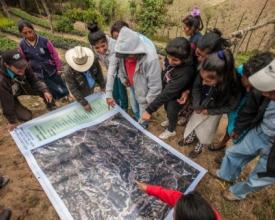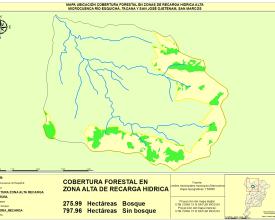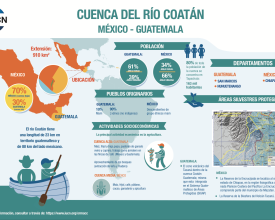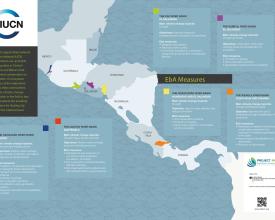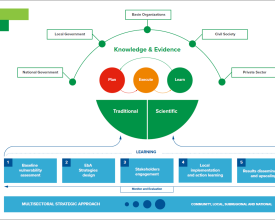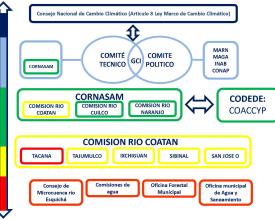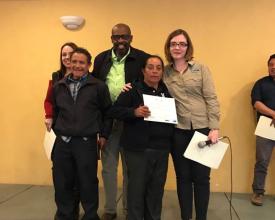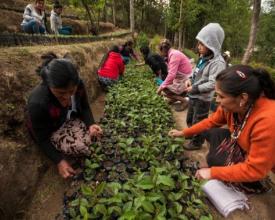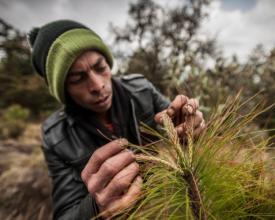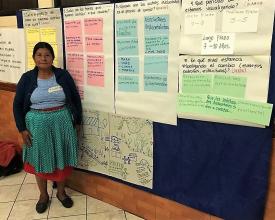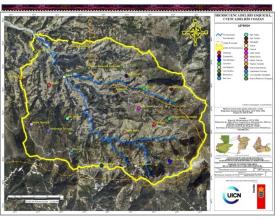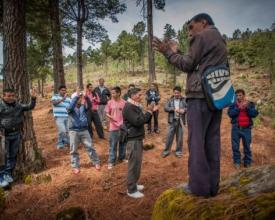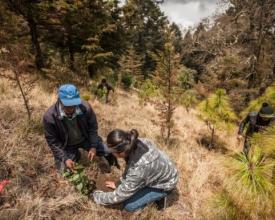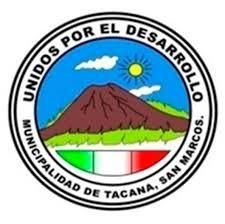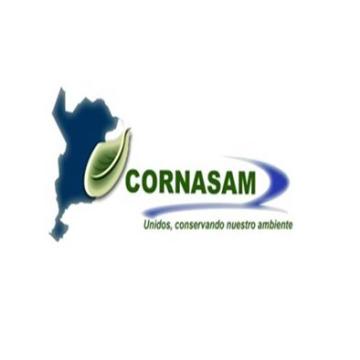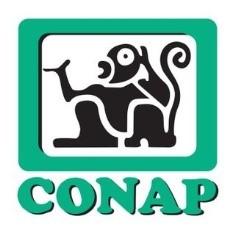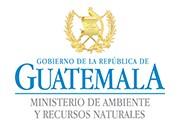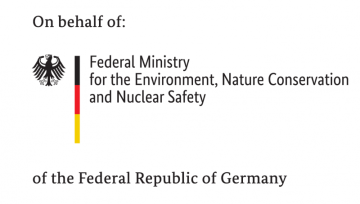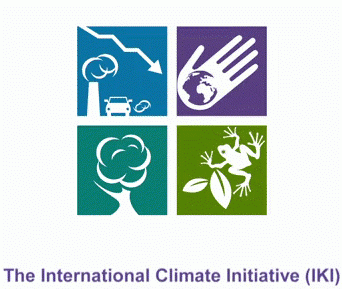
Gouvernance pour l'adaptation dans les hautes terres du Guatemala
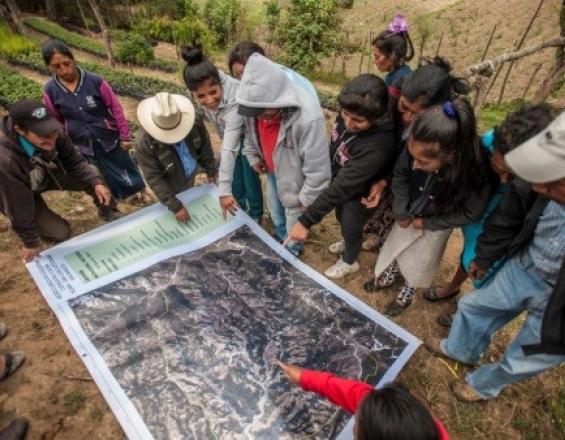
La population indigène du micro-bassin de la rivière Esquichá (municipalité de Tacana, dans la partie supérieure du bassin de la rivière Coatán) vit avec des taux élevés de pauvreté et de vulnérabilité climatique. Le micro-bassin (38 km2) présente des tendances à la déforestation, aux dégâts causés par le charançon du pin, à l'érosion des sols, aux variations des précipitations, aux vents forts, aux sécheresses et aux gelées, qui augmentent les risques de glissements de terrain et de pertes de biens. Afin de relever ces défis, les besoins des communautés en matière de restauration, de protection et de réparation des forêts, ainsi que de productivité, ont nécessité une attention particulière. Pour ce faire, la gouvernance du micro-bassin a été renforcée par une approche multidimensionnelle, participative, flexible et écosystémique. La solution combine ces quatre éléments pour renforcer les capacités communales et municipales de gestion des ressources naturelles et gérer les zones de recharge en eau comme une stratégie d'adaptation. En conséquence, la municipalité de Tacaná allouera des ressources aux mesures d'EbA dans le cadre du plan de développement.
Contexte
Défis à relever
- Les communautés agricoles indigènes sont vulnérables aux effets du changement climatique (fortes variations des régimes pluviométriques, ouragans, vents violents, sécheresses, gelées, glissements de terrain, érosion des sols, pertes de récoltes, dommages aux infrastructures).
- Les agriculteurs sont peu éduqués et très pauvres, ce qui peut réduire l'accès aux informations météorologiques et à d'autres facteurs augmentant leur capacité d'adaptation. Peu d'opportunités économiques dans la région, ce qui limite la mise en œuvre des technologies agricoles.
- Les forêts sont soumises à de fortes pressions, notamment celles qui abritent des sources d'eau, des menaces liées au charançon du pin et d'autres qui relèvent de systèmes coutumiers.
- Lacunes dans l'application des lois et règlements relatifs à la gestion de l'eau et des ressources naturelles (Constitution, code municipal, code de la santé, loi sur les forêts).
- Nécessité d'améliorer la coordination entre les différentes juridictions administratives, les différents niveaux de gouvernement (communauté, municipalité, département, région, pays) et les différents secteurs, pour des actions d'adaptation plus intégrées.
Emplacement
Traiter
Résumé du processus
La gouvernance pour l'EbA fait référence à la manière dont le pouvoir est exercé, les responsabilités sont distribuées et les décisions sont prises pour répondre au changement climatique avec des solutions basées sur la nature. Cette solution propose un modèle de gouvernance multidimensionnel (BB1), participatif (BB2), flexible (BB3) et avec une approche écosystémique (BB4).
- BB1, l'articulation entre les municipalités, les communautés et les institutions nationales a été renforcée pour garantir l'accès aux incitations forestières.
- BB2, la gouvernance a été renforcée afin d'être plus inclusive et de favoriser l'autonomisation locale, en particulier des femmes, ce qui a permis d'accroître la participation locale.
- BB3, les mesures ont été suivies et évaluées afin de prendre des décisions éclairées et d'influencer les instruments de politique et de gestion en ce qui concerne les incertitudes futures sur l'étendue des impacts du changement climatique/des impacts liés au climat.
- BB4, l'approche écosystémique a été intégrée dans la planification municipale locale.
Blocs de construction
Une gouvernance multidimensionnelle pour l'adaptation
Le conseil du micro-bassin de la rivière Esquichá sert de plateforme de dialogue, de plaidoyer, de renforcement des capacités et d'appropriation des leçons apprises et des outils ; c'est donc un moyen essentiel d'étendre l'EbA à différents niveaux. Dans l'optique d'une mise à l'échelle verticale, les enseignements tirés de son travail ont influencé différents niveaux :
- la municipalité de Tacaná, qui inclura des mesures d'EbA dans la planification municipale.
- le Conseil de la rivière Coatán (uniquement avec les autorités nationales guatémaltèques), qui facilite la coopération et la gestion intersectorielles avec une vision à l'échelle du bassin, au-delà de la simple sphère politico-administrative.
- le coordinateur des ressources naturelles et de l'environnement du département de San Marcos (CORNASAM). CORNASAM coordonne les efforts des acteurs gouvernementaux et des ONG, ainsi que des municipalités du département de San Marcos.
- le Secrétariat national à la planification (SEGEPLAN), afin d'améliorer les lignes directrices données aux municipalités en matière de planification.
- le ministère de l'environnement (MARN), qui utilise les enseignements tirés pour développer un projet du Fonds vert pour le climat qui met en œuvre des mesures d'EbA.
- l'Institut des forêts (INAB)
Des travaux supplémentaires sont nécessaires pour obtenir une coordination binationale du bassin du fleuve Coatán, partagé entre le Guatemala et le Mexique, afin d'avoir un impact plus important sur les avantages de l'EbA.
Facteurs favorables
- Utilisation des connaissances traditionnelles et des expériences locales pour sélectionner les mesures d'EbA, permettant l'application de l'EbA
- La structure participative du conseil du micro-bassin de la rivière Esquichá, qui se compose des conseils de développement communautaire des communautés locales, a favorisé la possibilité de travailler de manière organisée et d'influencer les niveaux supérieurs (par exemple les conseils municipaux).
- L'existence de CORNASAM depuis 2004 a été un facteur favorable, car l'objectif de cette plateforme correspond bien à l'objectif d'amélioration des capacités d'adaptation dans le micro-bassin.
Leçon apprise
- Les plateformes telles que CORNASAM sont idéales pour renforcer la gouvernance en matière d'adaptation, car elles rassemblent des institutions et des autorités nationales et infranationales de différents secteurs (intégration verticale). CORNASAM cherche à réduire les approches isolées et vise à faciliter l'identification des avantages mutuels et des synergies entre les secteurs et leurs besoins d'adaptation (intégration horizontale).
- La gouvernance de l'EbA doit promouvoir une participation ouverte, équitable, respectueuse et efficace, de sorte que les processus de planification et de prise de décision soient enrichis par la participation et que les résultats soient acceptés par toutes les parties concernées.
Une gouvernance participative pour l'adaptation
Pour renforcer la gouvernance, il fallait améliorer la participation du gouvernement et des parties prenantes locales à la gestion du micro-bassin.
Au niveau local, la base organisationnelle des communautés a été renforcée par les chefs de communauté et leur compréhension de l'importance des zones de recharge en eau. Elle a également été soutenue par les commissions forestières communales, généralement administrées par des femmes, et par les conseils de développement communautaire, qui ont été plus fortement intégrés au conseil du micro-bassin de la rivière Esquichá. Ainsi, la participation a été catalysée de la base vers le sommet, notamment avec la participation des jeunes, en particulier lors des événements de reboisement qui ont rassemblé plus de 1 000 personnes.
Le rôle de l'État s'est également accru grâce aux dialogues et aux accords avec les municipalités, et à l'accès des communautés aux incitations forestières. La plus grande valeur ajoutée a été l'autonomisation locale obtenue par la mobilisation sociale (y compris des femmes), "l'apprentissage par l'action" (processus qui implique la mise en œuvre d'activités EbA, associée à un programme pratique de renforcement des capacités), la capacité organisationnelle, les processus de gouvernance des communautés et des micro-bassins. Ce qui a été réalisé est le reflet d'un engagement fort de la communauté grâce à une gouvernance participative.
Facteurs favorables
- Les impacts liés au changement climatique, et en particulier la disponibilité de l'eau, sont des facteurs de préoccupation pour la plupart des acteurs des micro-bassins versants. Cette prise de conscience renforce leur volonté de participer aux processus de dialogue, à l'apprentissage permanent, à la recherche de solutions et aux actions conjointes. À Esquichá, les événements météorologiques extrêmes des années précédentes ont fortement touché plusieurs communautés, causant des dommages à la fois aux actifs (par exemple, les cultures, les logements, les infrastructures de production) et aux ressources en eau.
Leçon apprise
- Le conseil du micro-bassin de la rivière Esquichá réunit les municipalités, les COCODE (conseils de développement communautaire), les commissions communales des pépinières forestières et les représentants des municipalités. L'engagement de renforcer ces structures communales a été très efficace, étant donné que la plus grande capacité d'organisation et le leadership des femmes dans les communautés ont contribué à consolider la gouvernance du conseil de micro-bassin.
- L'autonomisation des femmes profite à la gestion des ressources naturelles et à la cohésion sociale des communautés. Dans l'arène des commissions communales des pépinières forestières, les femmes ont senti qu'elles avaient beaucoup à apporter et, s'étant approprié ces espaces, leur confiance pour participer à d'autres structures s'est également accrue.
- Les femmes ont appris qu'elles pouvaient agir et qu'elles étaient des acteurs clés dans la promotion de la restauration des forêts pour la recharge en eau. Elles ont appris que l'action collective et le leadership sont nécessaires pour les actions à l'échelle de la restauration.
Une gouvernance flexible pour l'adaptation
Les options de gouvernance et les réponses à l'adaptation au changement climatique sont nouvelles et doivent être en constante évolution ; les décisions et le plan de gouvernance doivent être flexibles ; l'adaptation doit donc progresser dans le cadre d'une approche flexible. Cela est possible grâce à l'application de mesures d'EbA avec un "apprentissage par la pratique" tout en utilisant les meilleures informations scientifiques disponibles sur les scénarios climatiques et en informant les instruments politiques locaux et nationaux.
La vulnérabilité climatique d'Esquichá a été évaluée à l'aide de l'outil CRiSTAL ("Community-basedRisk Screening Tool- Adaptationand Livelihoods").
Après une première planification des activités d'EbA, les actions d'intégration de la flexibilité ont été les suivantes :
- L'évaluation périodique des actions EbA sur le terrain et l'adoption de décisions à court terme.
- Les résultats du suivi et de l'évaluation seront essentiels pour inclure des ajustements importants.
- l'inclusion de mesures d'EbA dans le plan de gestion du micro-bassin
- L'évaluation des mesures pour informer le plan de développement de la municipalité.
- Information des résultats aux autorités compétentes comme la municipalité de l'Institut forestier (INAB). Cela a conduit l'INAB à rechercher des outils pour améliorer la façon dont les incitations sont attribuées et pour identifier les communautés situées dans des zones de captage d'eau clés.
Facteurs favorables
- L'intérêt politique pour l'intégration de l'EbA et des critères de sécurité de l'eau dans les programmes d'incitation forestière s'est accru.
- Intérêt politique de la municipalité de Tacaná.
- Capacité technique de la municipalité de Tacaná.
Leçon apprise
- Les informations doivent intégrer les sciences (physiques, biologiques, économiques et sociales) et les connaissances traditionnelles et autochtones.
- L'approche "apprentissage par l'action" ou "apprentissage par la pratique" est un élément clé de la flexibilité de la gouvernance en matière d'adaptation. Des améliorations constantes doivent toujours être recherchées et les pratiques, stratégies et politiques qui contribuent à accroître la résilience socio-environnementale doivent être évaluées. Grâce à cette approche, les membres du conseil du microbassin de la rivière Esquichá sont plus conscients, d'une part, des cadres juridiques et politiques qui facilitent la gouvernance multidimensionnelle et l'articulation nécessaire pour faire face au changement climatique et, d'autre part, de la nécessité de suivre et d'évaluer, au fil du temps, les avantages que les écosystèmes apportent à l'adaptation et aux moyens de subsistance locaux.
Ressources
Réaliser l'approche écosystémique pour l'adaptation
Dans le cadre d'une approche d'adaptation basée sur les écosystèmes et d'une vision par micro-bassin, les efforts déployés à Esquichá se sont concentrés sur l'amélioration des moyens de subsistance et de la résilience des écosystèmes afin de réduire la vulnérabilité au changement climatique. Les tempêtes tropicales et les ouragans tels que le Stand ont affecté les communautés par le passé (infrastructures hydrauliques, érosion ou perte de sources d'eau). L'application d'une approche écosystémique faisait partie du renforcement de la gouvernance pour l'adaptation au changement climatique dans le micro-bassin hydrographique d'Esquichá.
Les mesures mises en œuvre sont les suivantes
- protection et récupération des forêts dans les zones de recharge en eau. Par exemple, la protection des forêts de pins(Abies guatemalensis) qui abritent des sources d'eau alimentant les populations de la partie inférieure du micro-bassin.
- Restauration des terres dégradées et stabilisation des pentes
- la mise en œuvre et l'optimisation de systèmes agroforestiers.
En outre, la nécessité d'une approche plus intégrée de la gestion des ressources en eau a été largement acceptée, en partie en raison de la pénurie d'eau dont souffrent les communautés pendant la saison sèche et dans les parties supérieures du micro-bassin. Le concept de responsabilité sociale environnementale a également été promu parmi les communautés, selon lequel les communautés en amont prennent des mesures qui profitent aux communautés en aval.
Facteurs favorables
- Le changement climatique, et en particulier la disponibilité de l'eau, sont des facteurs qui préoccupent la plupart des acteurs des micro-bassins versants, ce qui accroît leur volonté de donner la priorité aux actions qui favorisent les zones de recharge en eau et la réduction des risques de catastrophe. À Esquichá, la survenue d'événements extrêmes au cours des années précédentes a fortement touché plusieurs communautés, causant des dommages à la fois aux biens (cultures, logements, infrastructures productives) et aux ressources en eau.
Leçon apprise
- Afin de prouver l'efficacité des mesures d'EbA mises en œuvre pour contribuer à la résilience des communautés face au changement climatique, et donc de renforcer la confiance dans la stratégie adoptée, la première étape a consisté à promouvoir le reboisement dans les parties supérieures du micro-bassin (où se trouvent les sources d'eau) ou dans les zones touchées par les glissements de terrain, ainsi que le travail communautaire autour des pépinières forestières. Ces actions ont permis de consolider le concept selon lequel la couverture forestière est une "assurance collective" face au changement climatique.
- L'évaluation des services écosystémiques du bassin a permis de considérer l'adaptation comme une tâche incombant à toutes les communautés, un moyen d'obtenir des avantages tant pour le micro-bassin d'Esquichá que pour d'autres communautés situées plus bas dans le bassin de la rivière Coatán.
Impacts
- Les membres du comité du micro-bassin de la rivière Esquichá unissent et coordonnent leurs efforts pour accomplir les tâches administratives et physiques nécessaires à la restauration du couvert forestier dans les zones de captage d'eau prioritaires.
- Les communautés intègrent des mesures d'EbA dans le plan de gestion du micro-bassin.
- Avec le soutien de la municipalité de Tacaná, les communautés influencent les niveaux supérieurs (conseils municipaux et départementaux, Institut national des forêts -INAB) pour l'allocation des ressources financières. Elles ont accès à des incitations forestières pour la restauration des forêts touchées par des parasites et situées dans des zones de recharge en eau.
- Allocation budgétaire de la municipalité de Tacaná pour des projets de restauration dans les zones de recharge en eau du micro-bassin hydrographique d'Esquichá, et inclusion de l'AbE dans le plan de développement municipal mis à jour.
- Grâce au coordinateur des ressources naturelles et de l'environnement de San Marcos (CORNASAM), il y a une meilleure coordination entre les acteurs du bassin, y compris les ONG qui exécutent des projets dans le bassin de la rivière Coatán et à San Marcos.
- Les leçons sont partagées à l'échelle nationale avec le ministère de l'environnement et seront mises à l'échelle dans le cadre d'un projet GCF dans les hauts plateaux guatémaltèques.
Bénéficiaires
- Directement : 16 communautés indigènes du groupe ethnique Mam, vivant principalement de l'agriculture de subsistance (~500 personnes)
- Indirecte : 2039 familles dans le micro-bassin versant d'Esquichá (~12125 habitants)
- Municipalité de Tacaná
- Municipalité de San José de Ojetenam
Objectifs de développement durable
Histoire
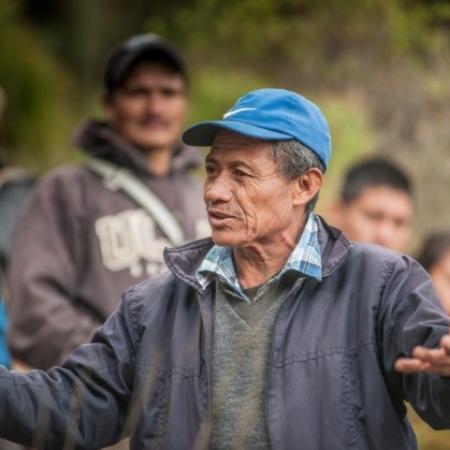
"Avant, chaque communauté travaillait de son côté et dans son propre espace. Aujourd'hui, nous sommes conscients qu'en travaillant ensemble, nous obtiendrons de meilleurs résultats ; désormais, 16 communautés participent aux réunions du conseil du micro-bassin d'Esquichá et, au-delà des réunions, nous menons des actions conjointes. Tous ces efforts s'expliquent par le fait que nous sommes tous affectés par le changement climatique, pas seulement une communauté... mais toutes les communautés, comme les fortes gelées, les vents violents, les sécheresses prolongées, les pluies intenses, et nous perdons des récoltes, entre autres choses.
Nous sommes allés frapper aux portes de chaque communauté pour leur demander de nous accompagner aux réunions et nous avons reçu une réponse négative, mais cela ne nous a pas découragés. Aujourd'hui, nous sommes satisfaits de la grande participation que nous avons, d'autant plus que nous menons des actions conjointement avec les communautés et que ce qui nous unit, c'est l'eau. Car si les communautés ne s'occupent pas des parties supérieures, ce sont les parties inférieures qui sont touchées. Le fait de considérer notre territoire comme le micro-bassin hydrographique d'Esquichá nous a aidés à intégrer les jeunes et les femmes.
Nous avons été reconnus par le ministère de l'environnement (MARN) comme l'un des conseils de microbassin ayant obtenu les meilleurs résultats... nous devons cela à l'accompagnement des institutions ; par exemple, avant, chaque institution venait seule et nous avions des réunions à tout moment parce qu'elles venaient de manière désorganisée. Aujourd'hui, les choses ont changé : lors des réunions du Conseil, des représentants de la municipalité sont présents, tels que le bureau municipal des forêts, le bureau des femmes, le bureau municipal de l'eau et de l'assainissement, ainsi que des organisations gouvernementales telles que l'Institut national des forêts, le ministère de l'agriculture, le MARN, et d'autres organisations telles que les Nations unies et l'Union internationale pour la conservation de la nature.
Cela a demandé beaucoup d'efforts, mais aujourd'hui, nous disons aux autres communautés qui nous rendent visite et qui découvrent notre expérience ce qu'elles doivent faire. Parce que ce qui nous a pris le plus de temps, ils peuvent le réduire.
Tous ces efforts nous ont ouvert des portes au niveau municipal (dans la municipalité de Tacaná), au niveau départemental et au niveau national [...]. Tout cela se traduit par la conservation de nos ressources naturelles - eau, sol et forêt - dans le micro-bassin hydrographique et tout cela mène à l'adaptation au changement climatique".
M. Roberto Escalante - Président du conseil du micro-bassin de la rivière Esquichá
